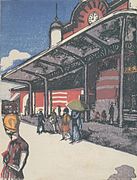Onchi Kōshirō
Onchi Kōshirō ( Japanese 恩 地 孝 四郎 ; born July 2, 1891 ; died June 3, 1955 ) was a Japanese woodcut artist and book cover designer. He was the first Japanese to deal with abstract art , was a co-founder and central figure of the Sōsaku-hanga movement.
Life
Onchi was the son of a lawyer at the Imperial Court Office , who also emerged as a calligrapher and China expert. His mother was a gifted koto player. From 1904 Kōshirō attended the Doitsugaku kyōkai gakkō , a school with German in the center, since he should become a doctor at the father's request. But in 1909 he left the school that had also taught him German culture, attended the Hakubakai painting school , and became friends with Takehisa Yumeji . In 1910 he began studying art at Tōkyō bijutsu gakkō (today Geidai ), but broke off his studies in 1915. As early as 1914 he had started with the late Tanaka Kyōkichi ( 田中恭 吉 ) and Fujimori Shizuo ( 藤森 静 雄 ) to publish the artist magazine Tsukuhae ( 月 映 , "moon gloss"). In 1918 he was involved in founding the Nihon sōsaku hanga kyōkai artists' association.
In 1938 Onchi was involved in the broad Nihon hanga kyōkai , from 1939 on they met in his "Society on the First Thursday". All his life he endeavored to promote, disseminate and gain international recognition for Japanese woodblock printing.
Artistic contribution
In 1911 Onchi created his first book cover for a book by the socialist Nishikawa Kōjirō . He then dealt intensively with book design, where he was interested in both western typography and the design of Chinese characters. Book design remained an important topic in his life. In 1915, under the impression of the death of brothers and friends, he created the series Joyō ( 抒情 , "compassion"). In 1917 he created illustrations and the cover for Hagiwara Sakutarō's collection of poems Tsuki ni haeru ( 月 に 映 え る , " Shine in the moon"). Before the Second World War he produced the "Poems" series and began the "Lyrik" series, adding fabrics to the woodcut plate, among other things, to further differentiate the prints. In 1934 he exhibited in Paris, in 1936 in Geneva and San Francisco.
Onchi also created woodcuts with representational motifs throughout his life.
Exhibitions
- 2014: Onchi Koshiro: The Abstract Prints. , Art Institute of Chicago .
literature
- Shibuya kuritsu shōtō bijutsukan (Ed.): Sōsaku hanga no tanjō (Birth of Sōsaku-hanga). Catalog 1999.
- L. Smith: Modern Japanese Prints 1912-1989 . Cover River Press, New York 1994, ISBN 1-55859-871-5 .
- Yutaka Tazawa (Ed.): Biographical Dictionary of Japanese Artists . Kodansha 1981.
- JA Michener: Japanese Prints. From the early Masters to the Modern . Tuttle 1959.
Web links
Remarks
- ^ Forerunner of the Dokkyō University .
- ↑ 一 木 会 Ichimoku-kai . This means a meeting on the first Thursday ( moku yōbi) of the month, a popular term for regular meetings, also of course on other days of the week.
Individual evidence
- ^ Museum page on the exhibition , accessed on April 27, 2014.
| personal data | |
|---|---|
| SURNAME | Onchi, Kōshirō |
| ALTERNATIVE NAMES | 恩 地 孝 四郎 (Japanese) |
| BRIEF DESCRIPTION | Japanese sōsaku-hanga wood cutter and book illustrator |
| DATE OF BIRTH | July 2, 1891 |
| DATE OF DEATH | June 3, 1955 |






